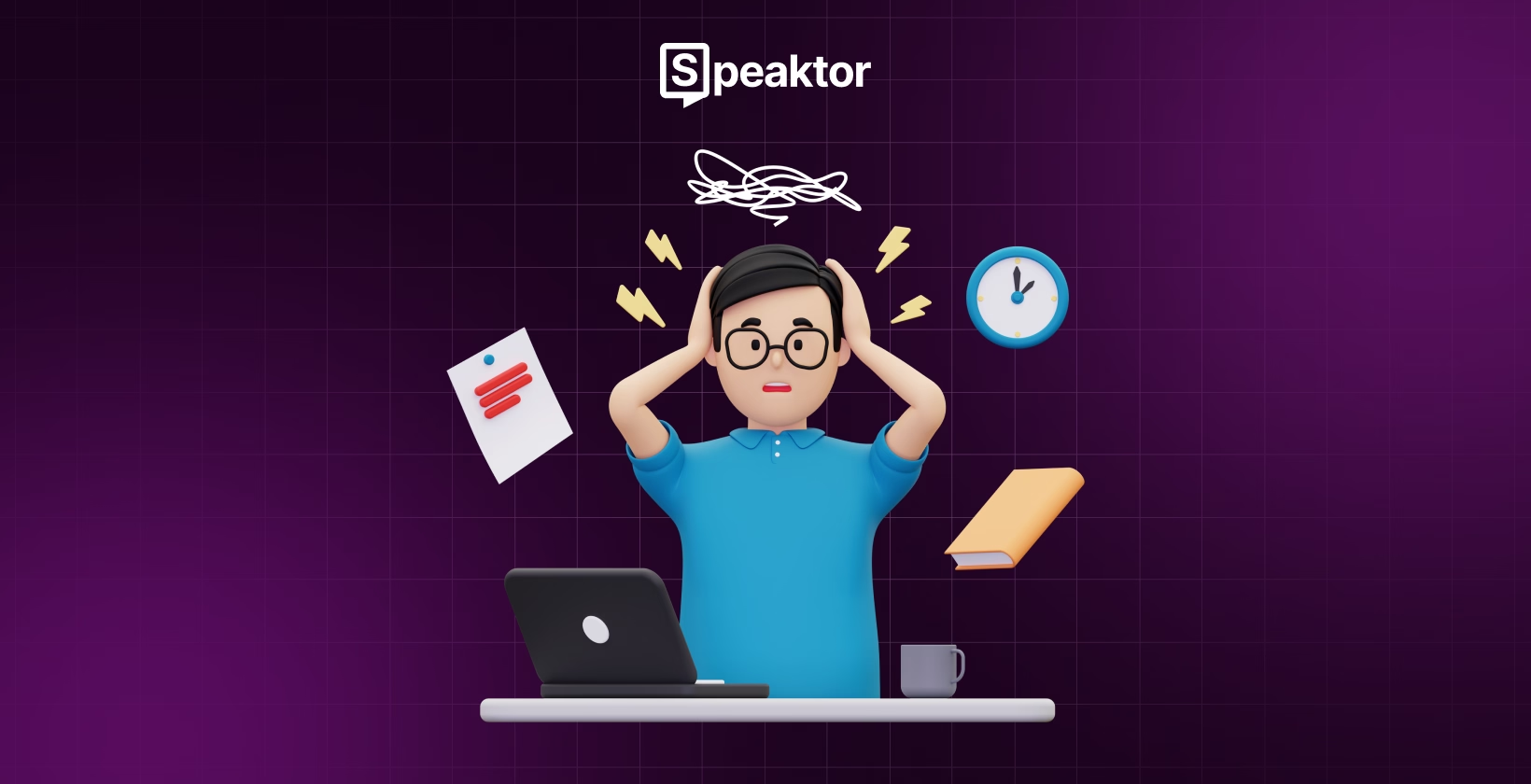
How to Focus with ADHD: Tips & Tools
Transcribe, Translate & Summarize in Seconds
Transcribe, Translate & Summarize in Seconds
TL;DR
Text-to-speech tools like Speaktor help ADHDers focus by turning reading into listening, reducing mental effort and making boring tasks easier to complete
Smart tools improve focus: visual timers, distraction blockers, co-working platforms, and to-do list apps create structure and reduce overwhelm
Focus with ADHD gets easier when you reduce friction, not when you rely on willpower
Challenges like time blindness, task initiation, reading fatigue, and digital distractions make it hard to stay on track
Small system tweaks go further than big overhauls. ADHD-friendly productivity is about building around how your brain already works
Start with one habit shift and let consistency turn it into a sustainable routine
Living with ADHD often means your brain is running faster than your to-do list.
One minute you’re deep in a project, and the next you’re pulled into a completely different task or lost in a new idea.
The constant shift makes it tough to stay focused.
But focusing with ADHD isn’t impossible.
Instead of forcing your brain to work like everyone else’s, the key is to understand why distractions hit harder and build systems that play to your strengths.
With the right tools and practices, you can turn scattered attention into sustainable productivity.
Real-life challenges ADHDers face that affect focus
Focus struggles in ADHD show up in subtle but very real ways across daily work, study, and routines. Here are six challenges that many ADHDers deal with and why they make concentration so difficult:
a. Reading fatigue and sustaining attention
Long documents, dense emails, or even short articles can feel like climbing a mountain.
You start reading with focus, but five minutes later you realize you’ve zoned out or reread the same paragraph three times.
The effort of forcing focus on written text drains energy quickly, leaving you mentally tired. That’s why reading-heavy tasks pile up and become easy to avoid.
b. Time blindness and losing track of time
For many ADHDers, time doesn’t feel linear. It’s either “now” or “not now.” That’s why starting a task can feel endlessly postponable, or why you suddenly look up from deep focus and realize hours have passed.
Time distortion leads to a chronic tendency to be late, missed deadlines, and stress when things take longer than expected.
Without external cues, it’s easy to overcommit or burn out from poor pacing.
c. Digital distractions
Notifications, buzzing phones, or an open social media tab are kryptonite for ADHD focus.
Each quick check isn’t quick; it pulls your brain into a new context, and returning to the original task feels like climbing uphill. ADHD brains also crave novelty, so the constant lure of something more interesting online can derail even high-priority work.
Over time, this creates a cycle of fragmented tasks and half-finished projects that chip away at productivity and confidence.
Interesting to note:
People with ADHD aren’t always distracted. When something truly grabs their interest, they can enter a state called hyperfocus: complete mental immersion where everything else fades away.
In this mode, they often work faster, think more creatively, and get more done than most people can during an average workday.
d. Overwhelm and task overload
A big project like “write a report” or “plan a presentation” often looks like one mammoth task instead of a series of steps. ADHD brains struggle with breaking vague tasks into smaller, manageable actions.
The result is overwhelm: staring at the task, procrastinating because it feels impossible, and then feeling guilty for not starting.
The executive overload is one of the biggest reasons ADHDers fall behind on deadlines.
e. Task initiation struggles
Even when you know exactly what to do, starting can feel like hitting a mental block. It’s called an initiation barrier, i.e., the gap between intention and action.
It’s not laziness; the ADHD brain struggles to switch gears from thinking to doing.
You might sit frozen before opening a document, or bounce between low-stakes tasks (like checking email) instead of the one that really matters. Once you finally start, momentum gets built, but the hardest part is taking that first step.
f. Difficulty maintaining focus in noisy environments
For ADHDers, filtering out irrelevant sounds is much harder, so each interruption feels amplified.
Background chatter in an office, traffic outside your window, or the TV in another room can completely knock focus off track.
Once concentration is broken, it can take 10-20 minutes to return to the same level of focus.
Did you know?
In the U.S., around 15.5 million adults, that’s about 6% of the adult population, are currently diagnosed with ADHD.
On the brighter side, now we have plenty of apps and tools that help ADHDers overcome these challenges.
At a glance: Key ADHD challenges and tools to solve them
| ADHD challenges | Tools | How they help |
|---|---|---|
| Reading fatigue/sustaining attention | Speaktor, NaturalReader, Speechify | Text-to-speech tools read text aloud in natural voices, improving retention and letting you listen while moving |
| Time blindness/losing track of time | Focus Keeper, TimeTimer, Be Focused | Pomodoro-style timers and visual countdowns make time more tangible, helping you pace work and breaks |
| Digital distractions | Forest, Freedom, Cold Turkey | Forest gamifies staying off your phone, while Freedom and Cold Turkey block distracting apps or sites during focus sessions |
| Overwhelm/task overload | Trello, Todoist, TickTick | Visual task boards and smart to-do lists break projects into smaller steps and send reminders so nothing slips through |
| Struggling to start tasks | Focusmate, Flown, Caveday | Virtual body-doubling and co-working sessions give external accountability and structure to get you started |
| Maintaining focus in noisy environments | Brain.fm, Noisli, Krisp | Brain.fm provides focus-enhancing music, Noisli generates ambient sounds, and Krisp cancels background noise on calls |
How text-to-speech helps with ADHD focus
Reading long blocks of text can feel exhausting with ADHD. The mind drifts, words blur together, and you’re suddenly three paragraphs in without remembering what you just read.
Text-to-speech (TTS) offers a simple but powerful workaround: it turns written content into audio, so you can listen instead of forcing yourself to stay locked on the page.
Here are a few ways TTS can make focusing easier:
1. Reduces cognitive load
Instead of decoding words, holding sentences in working memory, and trying to stay on track, TTS lets you listen and absorb information more naturally. Your mental bandwidth gets freed up for better comprehension.
2. Boosts retention with multisensory learning
Hearing words while following along on-screen engages both visual and auditory channels. Multisensory input can improve cognitive performance and help ADHD brains stay anchored to the material longer.
3. Matches your pace
When text is read aloud, it sets a natural pace. You can adjust speed to match your focus: slower when the content is complex, faster when you’re reviewing. Thanks to this flexibility, chances of zoning out mid-task is low.
4. Makes boring tasks easier
ADHD brains thrive on stimulation. Listening to a natural-sounding voice, rather than slogging through dense text, makes repetitive reading (e.g. reports or study material) more tolerable and less draining.
👉 If you’re looking for a text-to-speech tool, feel free to check out Speaktor. With clear, human-like voices, support for multiple languages, and easy text-to-audio conversion, it helps people with ADHD turn articles, notes, or assignments into something they can listen to on the go.
Best practices for using Speaktor for ADHD
1. Turn reading into active listening
Upload your notes, articles, or meeting transcripts into Speaktor.
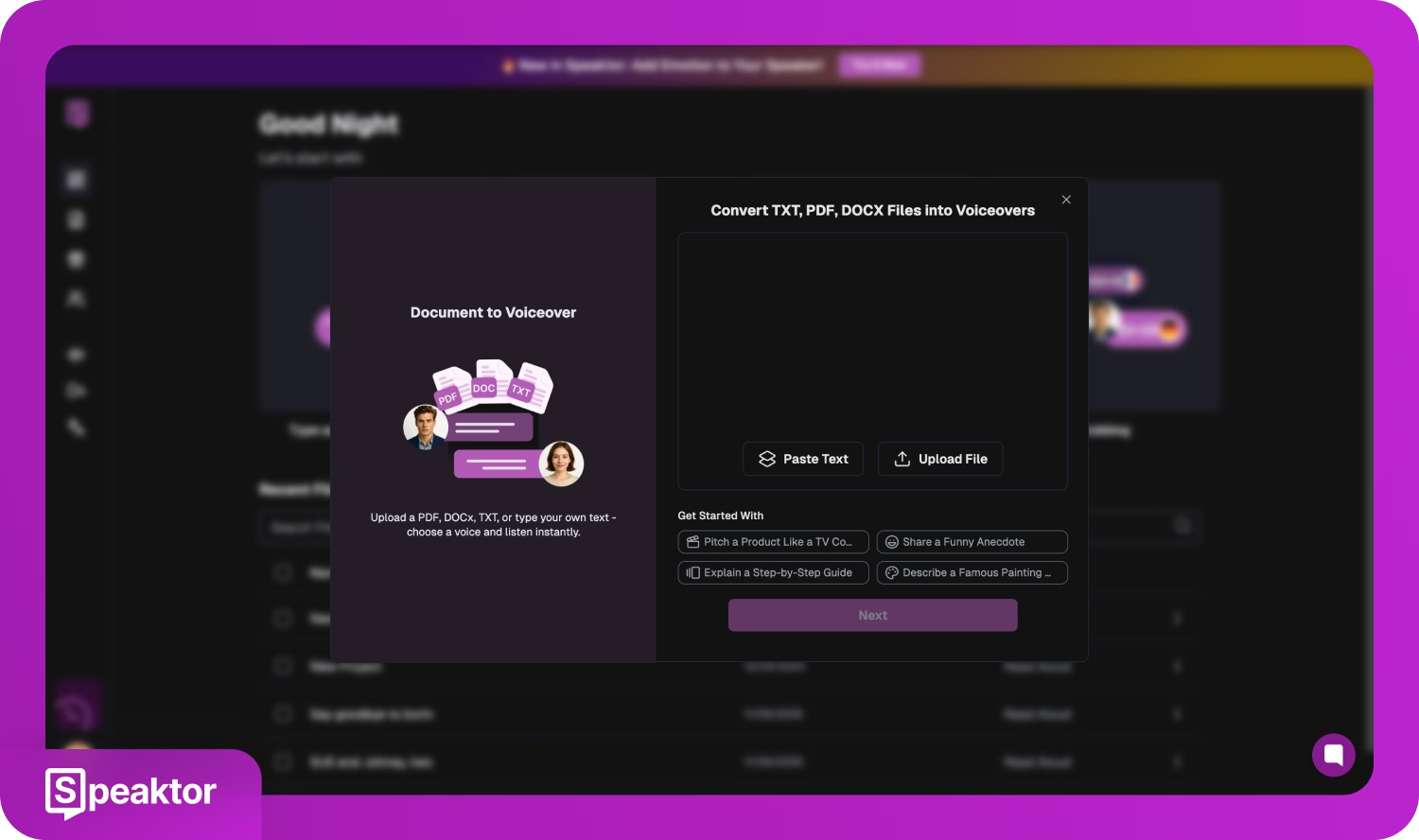
Play them back while walking, tidying your room, or doing light chores. Movement keeps your brain engaged while the audio sinks in.
You won’t burn out staring at text, and you’ll use your time productively.
2. Choose voices that match your focus state
The right voice matters. Some people with ADHD focus better with a calm, steady tone; others need a livelier one to avoid zoning out.
Speaktor offers a wide range of natural-sounding AI voices.
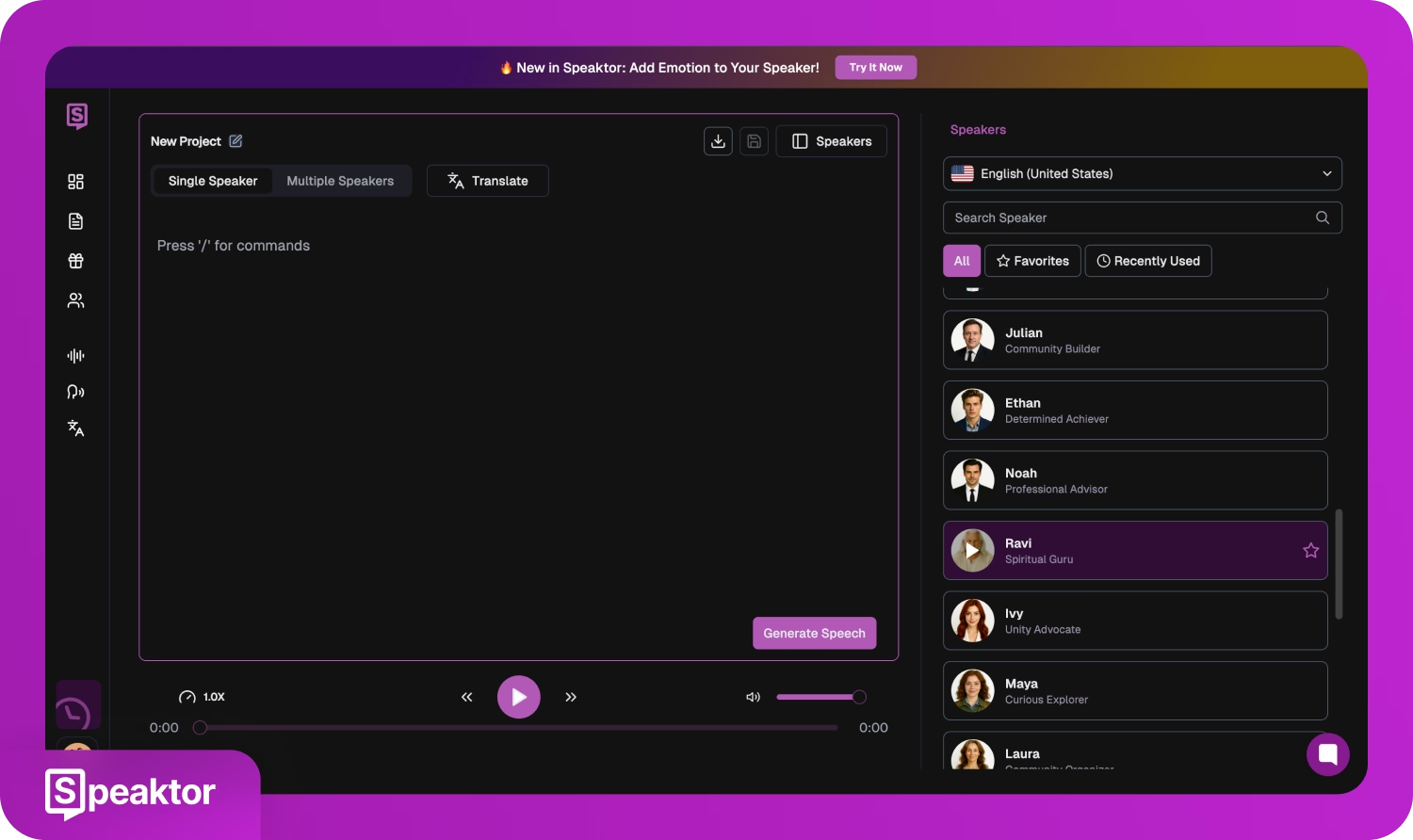
You can try a soothing voice for deep focus and an energetic voice for when you’re low on motivation.
Experiment with different voices and save the ones you love as ‘Favorites’.
3. Build audio task lists you can replay
Reading a long to-do list can feel overwhelming. Hearing it out loud keeps you moving.
Each morning, input your top 3-5 tasks into Speaktor, organized by priority. Play it back at the start of the day and again after breaks.
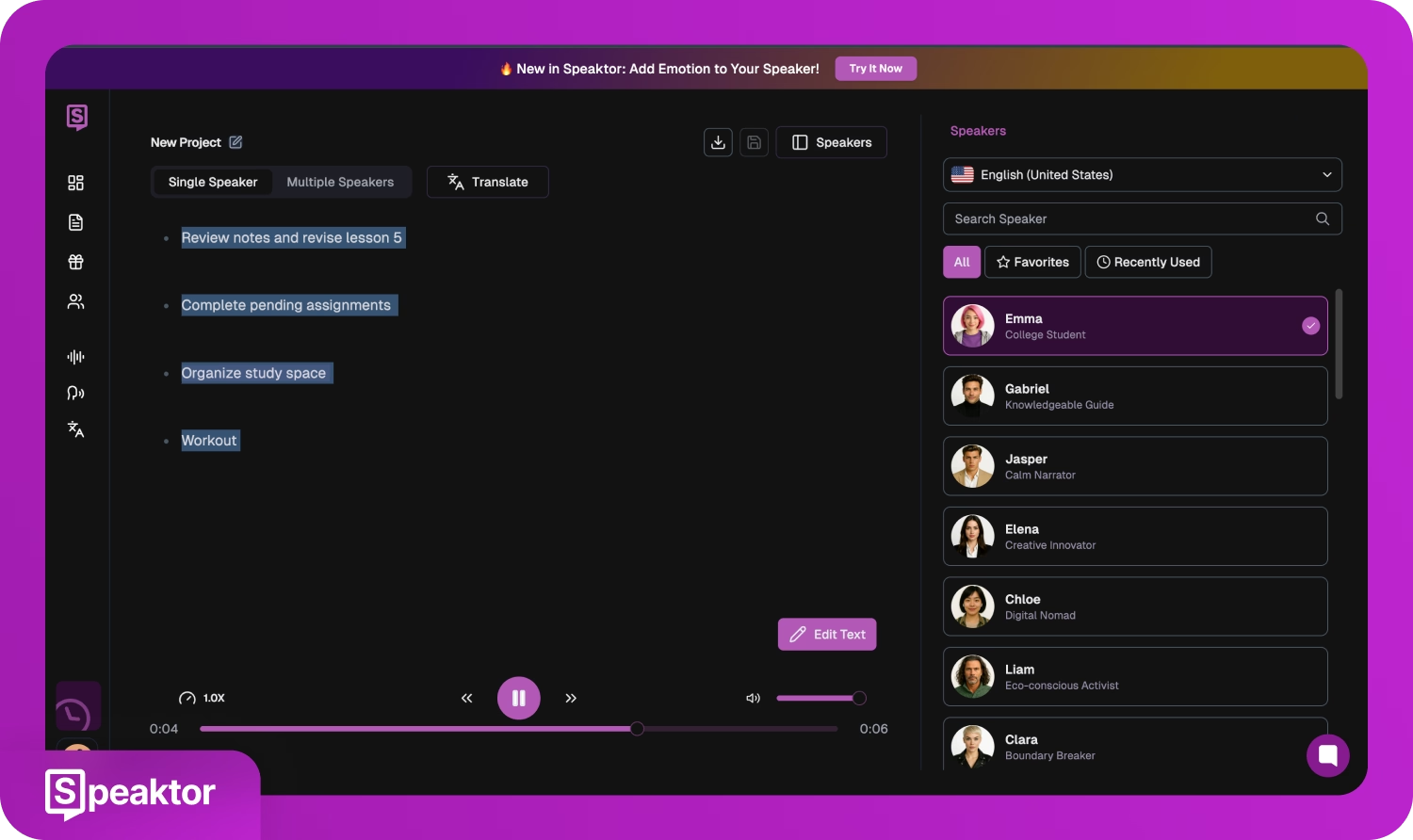
The audio format feels like a “daily briefing,” making tasks easier to remember and less intimidating.
4. Adjust playback speed to stay engaged
Attention can dip when content feels too slow or too fast.
Slow down playback for new material (like dense readings), speed it up for reviews, and change speed mid-session if your focus wavers.
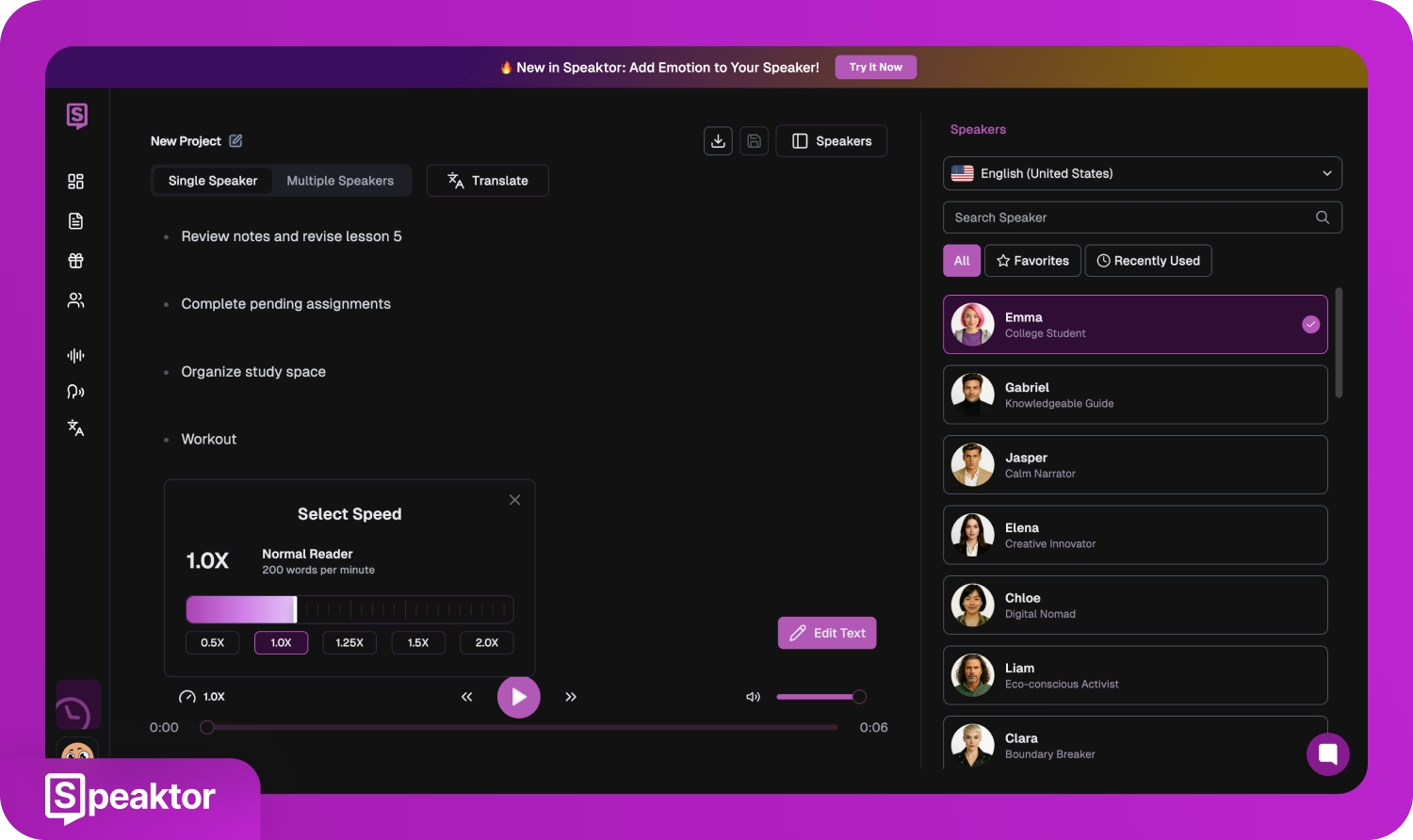
Matching audio pace to your energy keeps your brain from drifting.
Pro tip
Start with one habit at a time. For example, try replacing your written to-do list with an audio one for a week. Once it clicks, start using Speaktor for reading aloud your study sessions. Small, repeatable habits build long-term focus routines.
Tips to avoid ADHD pitfalls and maximize your focus
ADHD focus strategies can backfire if you slip into hidden traps, like spending more time setting up systems than using them. Here are practical ways to avoid those pitfalls and keep your attention where it matters:
| Pitfall | Why it happens | Practical fix |
|---|---|---|
| Constantly changing systems | ADHD brains crave novelty, so testing new apps or reorganizing planners feels productive but delays real work. | Commit to one tool or method for at least two weeks before switching. Consistency helps habits stick. |
| Struggling to start tasks | Every extra step (e.g. finding files, tidying a desk, deciding where to begin) adds friction and triggers procrastination. | Remove barriers in advance: open tomorrow’s document today, or set up your workspace the night before so the first click is effortless. |
| Focusing only on unfinished tasks | Endless to-do lists reinforce the sense that nothing gets done. | Write down every task you complete, even small ones. It builds motivation, shows proof of progress, and reveals patterns in your productivity. |
| Losing focus to boredom | ADHD brains thrive on stimulation, so monotony drives distraction-seeking. | Schedule intentional resets: change location, try background sounds, or process material differently (e.g., use text-to-speech instead of reading). |
Improve focus and make tasks interesting with Speaktor
If you live with ADHD, don’t try to force productivity through sheer willpower.
The real shift comes from building a routine that respects how your brain works.
That could mean listening instead of reading, using timers to make time feel real, or pairing up with someone who helps you start.
Start with one small change…one tool, one habit, and one method that reduces friction.
👉 Turn your text into audio with Speaktor and see if it keeps you more engaged!
Frequently Asked Questions
Start by minimizing friction. Break large tasks into smaller steps, use visual timers, and create an ideal environment that limits distractions. For example, pairing the Pomodoro technique with noise-canceling headphones can make a big difference during focused work sessions.
The ADHD brain can struggle with task initiation, prioritization, and follow-through, especially when there’s no immediate reward. Even the simplest tasks feel overwhelming. When you understand how brain chemistry drives motivation, it makes sense why last-minute pressure can suddenly unlock focus and productivity.
First, identify what’s interrupting your attention span. Is it internal noise, external triggers, or unclear next steps? Then, use sticky notes to jot down your ideas, take a short break before switching tasks, and rely on structured systems like checklists or reminders to stay grounded. These personalized strategies support your brain’s ability to return to the task at hand.
Yes. Tools like Speaktor (for turning reading into audio), Focusmate (for virtual co-working), and TimeTimer (for visual time management) support adults with ADHD. They reduce mental clutter, improve concentration, and make it easier to move from intention to action without burnout.
This is often related to the Zeigarnik effect, where unfinished tasks linger in your mind, but your brain resists starting them due to unclear steps or fear of not finishing. ADHD symptoms make this more intense under certain circumstances, like when stress is high or the task feels abstract. Using a timer, writing out the first small step, or standing up to walk around can help reset focus.
Routines that include physical exercise, consistent sleep, and structured breaks can help regulate attention levels. Using visual planners, setting recurring reminders, and creating a warm-up ritual before work can enhance your ability to stay focused across different daily tasks. Over time, these habits help your brain function with more clarity and stability
Yes. Even short mindfulness practices can help calm mental noise and improve attention levels. While the ADHD brain tends to seek stimulation, regular rest and mindful breathing can reduce cognitive overload. Meditation also helps with impulse control and stress regulation, making it easier to stay focused during demanding tasks.
Start by identifying just 1-2 high-impact tasks. Use color-coding, labels, or set reminders to distinguish between urgent and important. The goal isn’t to do more, but to manage energy and focus where it matters most. With ADHD, a visual hierarchy gives your brain the structure it needs to achieve meaningful progress without getting stuck midway.

